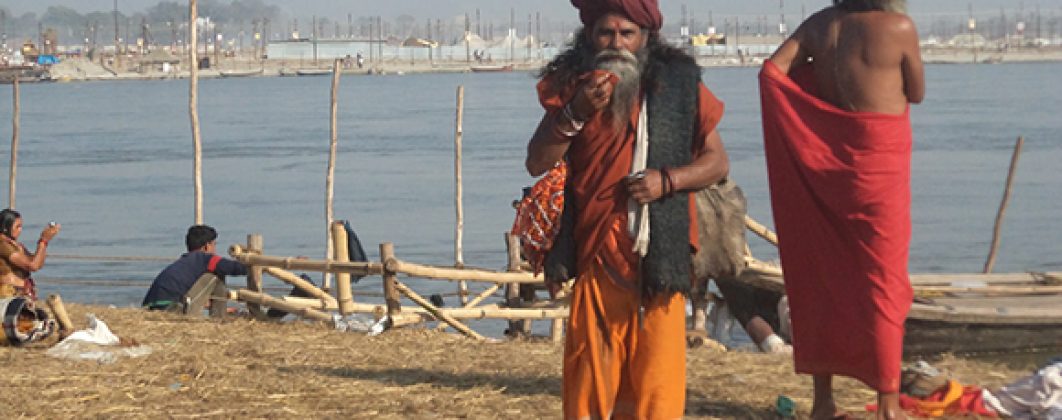

It is a dream come true for me. At last, I managed to take the pilgrimage to Maha Kumbh Mela, 2013. Though I had the intense desire to see the magnificent spectacle that is Kumbh Mela, all my attempts failed due to non-availability of tickets and lack of the right company. I was warned not to take a journey all alone. The media coverage of the Mela and narrative description of the people who have already visited had increased my urge to join the millions of pilgrims that visit this holy place every day to take a dip in the pious Sangam which is the meeting place of holy rivers Ganga, Yamuna and the mythical Saraswathi. A close friend of mine who sensed my heart made all arrangements for us and thus commenced my pilgrimage to Maha Kumbh Mela at Sangam, Allahabad, an event that comes once in 144 years.
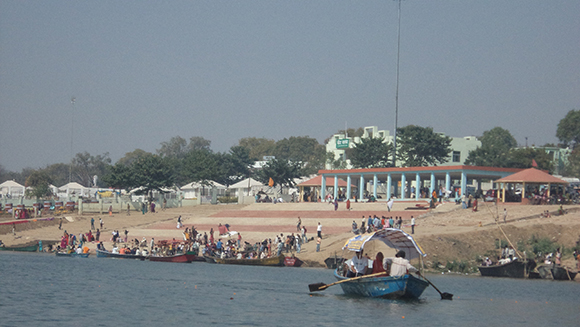
We are both from South India and are from different states. So we made our meeting point at Delhi. From Delhi we went to Varanasi. We stayed at Hotel Surya at Varanasi which is an erstwhile palace of the King of Nepal. We spent a day at Varanasi experiencing the glory of sunrise in River Ganga on a boat and in the evening participating in the Ganga Aarti ritual again from a boat. The next day we started early in the morning to Allahabad by a car. Our driver cum guide told us that there are two ways of taking a Snan (holy bath) at Maha Kumbh Mela. One from the banks of the Sangam and the second one is directly at the meeting place of the three holy rivers by sailing in a boat on the river Ganga and come to the location of the Sangam. We preferred the boat route and hired a boat at Bargad Ghat on the river Ganga at Allahabad and it took us almost an hour to reach the Sangam location.
There are boats in a row across the Sangam like a floating platform and our boat had stopped there. From our boat, we stepped into one of the stationed platform boat and the bathing ceremony is from the other side of the stationed boat. There were excellent arrangements to get into the water from the boat and some arrangements to change the clothes from a boat. I got into the waters and had my Maha Kumbh Mela Snan. Dream realised!! Then I looked around. The whole area was full of water to the extent I could see. Millions of people take bath in the waters from the Sangam banks and from the middle of waters of Sangam from the boats.
Having finished the main event of Maha Kumbh Mela Snan, we went around the Kumbh Mela city. What I have experienced in the Mela is enough to fill my heart with joy and my soul with bliss that would last till my end. I have collected more information about Maha Kumbh Mela and I have also taken some pictures which I would like to share with you.
What is Maha Kumbh Mela?
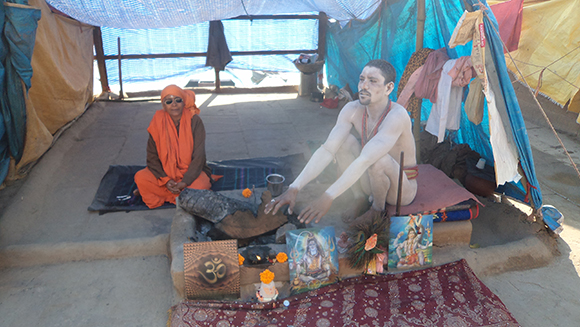
Maha Kumbh Mela means the great pitcher festival (Maha means great, Kumbh means pitcher and Mela means fair or festival). It is a Hindu pilgrimage of deep faith where massive gathering of devotees take a bath in the sacred rivers. It is the largest religious gathering in a single location in the world. Nearly 100 million people have taken their ritual bath during the Maha Kumbh Mela held at Sangam at Allahabad in the year 2013 which started with Makar Sankranthi Snan on January 14, 2013 and ended on March 10, 2013 with Maha Sivarathri Snan.
Where is the Prayag Maha Kumbh Mela located?
Sangam where Kumbha Mela is held is located about 7 kilometres from Allahabad city. Sangam is a Sanskrit word for confluence and it is here that the three holiest rivers of India – Ganga, Yamuna and Saraswathi meet in union. The meeting of the two rivers, Ganga in brown colour, and Yamuna in green colour, is clearly seen and it is the mythical invisible Saraswathi river that cannot be seen.
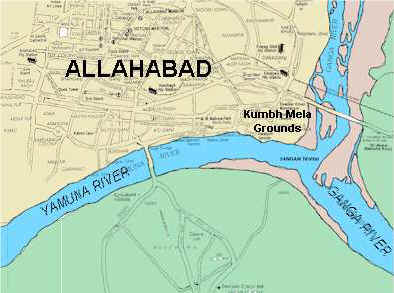
As per the Hindu mythology, Saraswathi exists ethereally, invisible to the human eye. It is mentioned in the holy scripts that river Saraswathi flows beneath the ground and surfaces only at Prayag (the ancient name for the present city of Allahabad) to join Ganga and Yamuna. Because of the confluence of three rivers, this place is also known as Triveni Sangam and is hailed as the king of holy places.
The Magic of Maha Kumbh Mela

The Maha Kumbh Mela held in Prayag Sangam attracts millions of pilgrims from all parts of India and foreign lands. It is a great site to see that devotees, young and old, male and female, rich and poor, strong and weak, married or single, Sanyasi or worldly men, scholars and uneducated, troubled and blessed, all come to Kumbh Mela at Triveni Sangam with a common goal of having a spiritual purification by having a dip in the sacred waters of Sangam.

It is believed that even in normal days the sacred bath at the confluence of the three rivers increases the purification of the body and soul by hundred times. A bath during the pious days of Kumbh Mela increases the spiritual effect by thousand times, particularly during the auspicious days assigned to Pavithra Snans (purification bath). Though self-purification is the main purpose for people to have a bath in the Sangam during the Kumbh Mela, they also come to pray for the departed parents and other relatives to attain higher levels of after death life by doing Pind Pradan (offering of morsel of food) and other rituals.
Places where Kumbh Mela takes place
Kumbh mela takes place once in 12 years at four places in India that are located at the river banks. Haridwar on the banks of river Ganga, Prayag at Sangam, the confluence of three rivers Ganga, Yamuna and the mythical river Saraswathi , Nasik at the banks of river Godavari and Ujjain at the banks of river Shipra. Thus, it is held every third year at one of the four places by rotation. It is 12 Kumbh Melas that make one Maha Kumbh Mela and Maha Kumbh Mela is held once in 144 years only at Sangam, Allahabad. It is a grand sight to see that endless millions of pilgrims and other participants gather on the Ghats and river beds presenting a panoramic view and vibrating with religious fervour that is a feast to the eyes and soothing balm to the soul. And this spectacle is possible only at Prayag Sangam.
What is the significance of “Kumbh” in Kumbh Mela

Kumbh which is a Sanskrit word literally means “Pitcher” in English and Kalash in Hindi. For an average Hindu household, the kumbh is an integral part of the daily life. The water is collected and stored in a kumbh. All the religious rituals are done by keeping a kalash symbolising the presence of Thrimurthi and all other Gods and Goddesses. When new temples are constructed and the Gods are installed, Kumbhabhi shekam (pouring water from a Kumbha) is done to the Gods and to the temple Sikhara (Peak). When pious people are received in the temple or at home, they are received with Poorna Kumbha (Full Kumbha). When the family enter their new house (Gruha pravesham) they enter along with Kumbh with water filled in it.
Hindu scriptures say that that the mouth (opening) of the Kumbh (Kalash) represents the presence of Vishnu, its neck represents Rudra, the base represents Brahma, the centre represents all Goddesses, the interior represents the entire oceans and the four Vedas. This is the significance of Kumbh. The following sloka in Sanskrit conveys the same meaning.
Kalashasya mukhe vishnu kanthe rudra samaashritah
Muletvasya sthito brahmaa madhye maatriganaah smritaah
Kukshau tu saagaraah sarve sapta dvipaa vasundharaa
Hrigvedo yajurvedo saamavedohrytharvanah
Angaishca saritaah sarve kalasham tu samaashritaah
According to the scriptures, all the great powers – the Trinity, the Devas, the seven continents and the Vedas exist in the Kumbh and are manifested together during the Maha Kumbh mela.

Kumbh is symbolic of life giving waters of the earth. All the waters of the earth like wells, tanks, rivers, and oceans are covered on all sides by earth. Similarly, the pitcher holds the water from all sides and hence signifies all the holy waters of the earth. This is the exact reason why all river festivals are called Kumbh Melas. The entire universe is Kumbh as the sky is covered by wind, the sun rays cover the universe with its light, and the human body is covered by cells. Lord Vishnu who is present in the entire universe and the entire universe is in himself is also a Kumbh.
The Origin of Kumbh Mela

According to Bhagavata Purana, the origin of Kumbh Mela starts with the mythological story of Samudra Manthan by Devatas and Rakshasas. Devatas and Rakshasas are arch enemies and there were regular wars between them to claim the superior position. The story further says that Devatas lost their energy and became weak due to the curse of Durvasa Muni and to restore their strength they go to seek the blessings of Lord Brahma and Lord Shiva. Both the Gods told Devas to pray to Lord Vishnu who could solve their problem. Devatas pray to Lord Vishnu and he tells them to churn the Ksheera Sagar (Primordial Ocean of Milk) by which process they get Amritha (the nectar of immortality).
Since this mighty job of churning the milky ocean cannot be accomplished by them alone, Devatas make a temporary truce with Rakshasas and seek their help in churning the ocean of milk with the understanding that they share equally the treasures that emerge from the ocean. They use Mandaragiri mountain as a churning stick and the great snake Vasuki as the churning rope. However, when the Kumbh (pitcher) containing Amritha came out from the churning of milky ocean, both Devas and Rakshasas claimed the ownership of the precious Kumbh containing Amrith that immortalises the one who drinks it.
They fought for 12 days for the possession of the Kumbh and it was Rakshasas that got the possession of the Kalash. Devatas then prayed to Lord Vishnu to save them from the calamity and to bestow Amritha Kalasa to them. Lord Vishnu appears on the spot as a beautiful lady in the Mohini Avathar (enchantress) and takes possession of the Amrita Kumbh by tricking the Rakshasas and hands it over to his Vahana (carrier), the heavenly bird Garuda. Garuda flies away with the Kumbh to reach Vaikuntam (the abode of Lord Vishnu) but Rakshasas try to grab the Kumbh of Amrit. In the struggle, the Amrith gets spilled and falls at four locations on the earth namely Haridwar, Prayag, Nashik and Ujjain.
On account of this, this place became very pious and Kumbh Mela is celebrated at these places to mark the event of amrit dropping from Kumbh. The struggle took place for 12 days between Rakshasas and Devatas and hence Kumbh Mela is celebrated once in every 12 years (one day for devas is equal to one earthly year) at these locations. Thus, the festivals at these locations are named after the holy Kumbh (Urn) that contained the elixir of life that is Amrit.

When is Kumbh Mela conducted? The Timing
For the four places where the Kumbh Mela is conducted, the time of the Mela and the duration of the celebration are decided by the planetary positions. Brihaspathi (Jupiter) and Surya (Sun) as mentioned below:
At Prayag – When Brihaspathi (Jupiter) is in Vrishabha Rashi (Taurus) and the Sun is in Makar Rasi (Capricorn).
At Haridwar – When Brihaspathi (Jupiter) is in Kumbha Rasi (Aquarius) and Surya (Sun) is in Aries. (Mesa Rasi)
At Ujjain – When Brihaspathi (Jupiter) and Surya (Sun) are in Vrishchika Rasi (Scorpio).
At Nashik – When Brihaspathi (Jupiter) and Surya (Sun) are in the Simha Rasi (Leo).
The dates for celebration of Kumbh Mela at each of the locations i.e. Haridwar, Prayag, Nashik and Ujjain are calculated in advance by studying the planetary positions by eminent pandits.
Most Auspicious Days during the Kumbh Festival
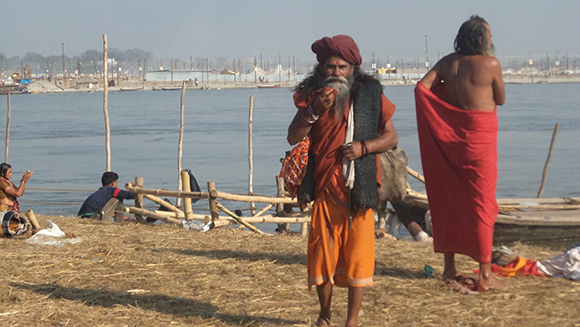
Ritual bathing (Snan) is the most important and auspicious ceremony in the Kumbh Mela. From all over the world, millions of pilgrims come to the Kumbh Mela just to have a dip in the holy waters during Kumbh Mela time. It is believed that those who take bath in the confluence of rivers Ganga, Yamuna and the mythical Saraswathi during the Kumbh mela will get rid of their accumulated sins (papa) and attain Moksha (salvation) which means one gets free from the vicious cycle of birth and death.
The important bathing days are called “Shahi Snan” which means Royal Bathing Days. Mouni Amavasya day which is the main bathing day attracts millions of people and on this day it is estimated that 35 million people had a dip in the Sangam for the year 2013 Maha Kumbh Mela at Prayag.
The following are the main and auspicious bathing days for the Kumbh mela, 2013. Shahi Snan starts at 6:00 a.m.

Maha Kumbh Mela 2013 Bathing (Shahi Snan) Dates
|
Bathing Dates |
Day |
Occasion |
Remark |
| 14th January 2013 | Sunday | Makar Sankarnti | First Shahi Snan |
| 27th January 2013 | Sunday | Paush Purnima | Full moon day |
| 6th February 2013 | Wednesday | Ekadashi Snan | 1th day of full moon |
| 10th February 2013 | Sunday | Mauni Amavasya Snan | Main Bathing Day (Dark moon) |
| 15th February 2013 | Friday | Basant Panchami Snan | Fifth day of the new moon |
| 17th February 2013 | Sunday | Rath Saptami Snan | Seventh day of the new moon |
| 18th February 2013 | Monday | Bhisma Ashtami Snan | Eigth day of the new moon |
| 25th February 2013 | Monday | Maghi Purnima Snan | Full moon day |
| 10th March 2013 | Sunday | Shivaratri Snan | The night dedicated to Lord Shiva |
The spirit of Kumbh Mela
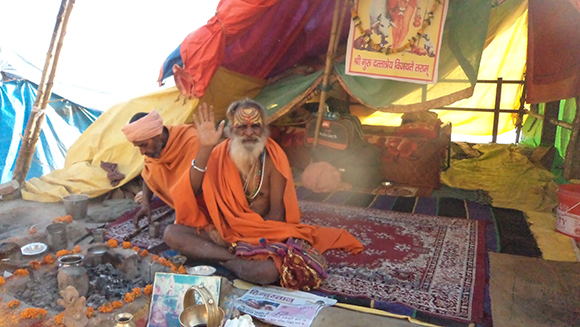
Kumbh Mela is a convention of Hindu Religion which is attended by Yogis, Sanyasis, Sadhus, religious heads, and holy men of spiritual attainment. Most of the Sadhus live in mountain caves, Himalayas, forests and other spiritual retreats and come out to mingle with the common public only during the Kumbh Mela. A special tribe of saints known as Naga Babas are the main attraction of the Kumbh mela. These are followers of Lord Shiva and smear their naked bodies with Ash. It is believed that even a bath at regular days during the Kumbh mela liberates the soul from the cycle of birth and death and also the ancestors of 88 generations are benefited by this pious act. It is said in Vishnupurana that if anybody takes bath during the Shahi Snan days, the spiritual benefits one gets is greater than the benefits one gets by doing 1,000 Aswamedha Yagas or the benefit one gets by doing Pradakshina (circumambulation) to earth 1,00,000 times.
Mela means festival. But as far as Kumbh mela is concerned, it is a festival of knowledge, traditional wisdom of spirituality, celebration of Hindu thought, philosophy, way of life and faith system, Hindu sampradaya (traditions) and practice of Hindu Dharm.
Naga Babas
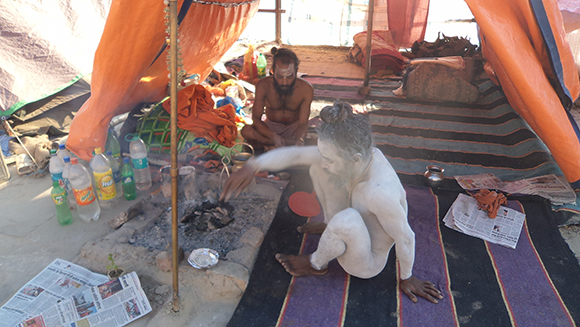
Naga Babas are followers of Lord Shiva. They are naked and hence they are called Naga babas (Nag means naked). Even during the Himalayan winters, they remain naked. Naga Sadhus smear their bodies with ash, and have matted locks of coiled hair. Their weapon is trident. They smoke Ganja (marijuana) through an earthen pipe called Chillum or Shiv Muli. Naga Sadhus practice celibacy and avoid materialistic way of life. They live in Himalayan caves and come to the outside world only during Kumbh melas. This is the only rare occasion one can see Naga Babas.
Scriptures say that Naga sadhus were formed by Lord Dattatreya. Subsequentl,y Aadi Sankaracharya organised them as a strong Hindu religious group to protect and spread our ancient wisdom and way of life which is called Sanatana Dharma.
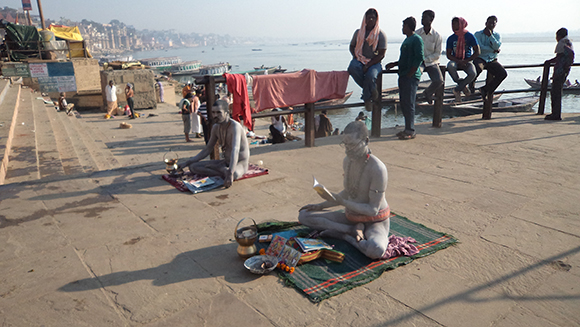
The Naga sadhus form their own mysterious and secret society. Naga Sadhus live in a place called “Akharas”. They are a group of Warrior-Ascetics. The member of an Akhara should be ready at any time for a spiritual fight or physical fight to protect their community. To become a Naga Sadhu, one has to become a sadhu at a very young age. Kumbh Melas are the times when the Naga group arranges selection of young recruits. Some of the parents voluntarily donate their boys to the Naga community as a token of their service to Hindu religion. The moment the boy is accepted into Naga Community after religious ceremonies, the first thing they do is strip the boy off his clothes and smear his body with ash. This is in symbolism to cut off from the materialistic world and enter into a spiritual detached life.
Other Rituals in Kumbh Mela
Apart from Shahi Snan there are other rituals that are done for the wellbeing of the ancestors, family and for society at large.
Veni Danam
Veni danam is a ritual where the women offer a part of their hair to the Ganga river at sangam for the wellbeing and long life of their husband. Veni means hair and Danam means offerings. The Veni Danam ritual is very interesting. The lady washes the feet of her husband in a plate and the water is sprinkled on her head. Later, her husband puts the vermillion on her forehead, combs her hair, divides the hair into three streams and plaits her hair. He then decorates her hair with flowers and cuts off few strands of hair from the tip of the plaited hair. The hair is sanctified by applying wet turmeric over it and placed on a prayer plate.
Other auspicious items like flowers, betel leaves and nuts, kumkum, haldi, mirror, comb and bangles are also placed in the plate. The entire ritual is done in the boat at the Sangam waters. Then both the husband and wife get into the water and the wife offers the hair along with the other auspicious items to Ganga by pouring them into the waters. The surprising part is the hair sinks into the water instead of floating. Several ladies do Veni Danam at Sangam and when I had my bath at Sangam not even a single strand of hair was noticed.
The spiritual significance of Veni Danam is that plaiting the three streams into one single thick plait of hair signifies three rivers Ganga, Yamuna, and the invisible Saraswathi mixing at sangam forming one single Ganga river and it flows on. Though three streams of hair is used to plait the hair, only two streams of hair are visible outside and the third stream of hair is interwoven and invisible to the eye like the Saraswathi river that mixes with the other two rivers but is invisible. That is why the confluence of these three rivers is also called Triveni Sangam. The significance is that the human being, including the hair, is as pious as the three holy rivers created by God. Vedic thought says Aham Brahmosmi meaning “I am God”.
Pind Daan
Pind Daan is a ritual of offering food to the souls of the dead members of the family. Pind means a morsel of food in the form of rice or wheat cooked or powdered and mixed with water and Daan means offering by a ritualistic prayer. The Pind Daan is offered by a ritual called Shradh which is performed under the direction of a Brahmin well-versed in this ritual. It is believed that the Pind Daan will help the souls of the departed relatives to attain salvation. It is believed that the souls of the ancestors expect the feeding from the progeny by performing Shradh. Once the Pind Daan is given, the hovering spirits are satisfied and will attain salvation. Hence, Hindus consider it as their utmost duty to perform Pind Daan to the ancestors. The spiritual effect is much more if it is done at Kumbh Mela.
Sari Ganga Snanalu
This is a ritual bath in which the husband and wife stand together facing each other, hold their hands together, and take a dip in the waters of sangam at a time as a united and single body.
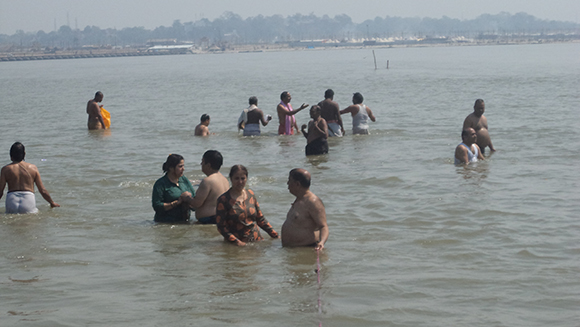
They have to take a bath like this for at least three times. Sari means same or together, Ganga means river Ganga and Snanalu means the plural of Snan which means bath. It is believed that the couple who does Sari Ganga Snanalu will be together as a couple for the next seven Janmas.

Copyright © 2021 YK Antiques Home Museum
3 Responses
Great Job, Annayya!
I encourage all my FB gang to go over this article! Good coverage!
Nice Experience Annayya..